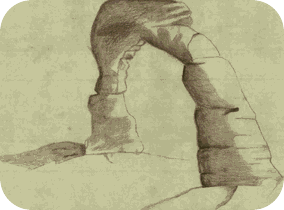Heritage Gateways
Official Sesquicentennial K-12 Education Projectsponsored by the Utah State Board of Education, the BYU-Public School Partnership and the Utah Education Network
Pioneer 1847 Companies
The Pioneer Trek of 1847 - Trail/Divisions and Topography

Image courtesy of: Heritage Gateway Project Images, These images have been gathered to support the Sesquicentennial celebration of the immigration to Utah.
West of Winter Quarters the Mormons followed generally what is sometimes called the Great Platte River Road or the north branch of the Oregon Trail, which had always been regarded as the most advantageous approach to the easiest crossing of the Rocky Mountains. The original Oregon Trail, from 1812, was north of the Platte and after Independence Missouri became the eastern terminus around 1827, it shifted to the south side. The Mormons of 1847 simply followed the older Oregon Trail to Fort Laramie, where they crossed the North Platte River and picked up the then main route of the Oregon Trail. (In trail days whatever side of the Platte a party started out on is the side it remained on; no emigrants crossed that river unless absolutely necessary. Had the Mormons started out south of the Platte, they probably would have remained on that side.) Among those who preceded the Mormons west along the north bank of the Platte were Indians, trappers, traders, Robert Stuart, James Clyman, Major Stephen H. Long, Samuel Parker, the Marcus-Whitman party of 1836, and the Townsend-Murphey group of 1844. And many non-Mormons followed the pioneers of 1847, for the Council Bluffs area was a very important and popular jumping off place throughout the westering period in American history.
The simplest way of following the pioneers (and most subsequent Mormon emigrants) from "civilization to sundown" is to divide the trail into four sections and relate them to the Oregon Trail, the "main street to the west."
- The Oregon Trail proper of the 1840s started at Independence, Missouri, and crossed Kansas, Nebraska, Wyoming, and Idaho. The first section of the Mormon Trail from Winter Quarters was generally along the north bank of the Platte River, some 185 miles to near what is now Kearney, Nebraska. Up to this point the Mormon Trail and the Oregon Trail of the late 1840s were entirely separate.
- The second portion of the Mormon Trail was from Kearney to Fort Laramie, Wyoming. Along this approximately 320-mile-long section, the two trails followed the Platte, the Mormons on the north bank and the Oregonians on the south. Since in the 1840s, the favored route to Oregon and California was along the south bank of the Platte, it might appear that the Mormons pioneered the north bank trail, but actually during the 1820s and 1830s the north bank had been the preferred way, used by fur trappers and missionaries. As late as 1846, the famous historian Francis Parkman took the northern route to South Pass.
- The third section of the trail was from Fort Laramie to Fort Bridger. Here the Mormons followed the Oregon Trail proper for some 397 miles.
- The fourth and final section of about 116 miles started at Fort Bridger, where the Oregon Trail turned north and where the Mormons left the Oregon Trail and picked up the year-old Reed-Donner track through the Rockies into the Salt Lake Valley.
West of Winter Quarters the Mormons passed along river valleys, across grasslands, plains, steppes, deserts, and mountains, and through western forests, experiencing dramatic changes in flora and fauna. Topographically the trail led across the Central Lowlands of eastern Nebraska, covered with the tall prairie grass of bluestem and needle; across the High Plains of central Nebraska and the Upland Trough of western Nebraska and eastern Wyoming, blanketed with short, stubby plains grasses such a grama and buffalo; through the Wyoming Basin with its desert shrub of sagebrush, creosote bush, and greasewood; through the forests of Douglas fir and scrub oak of the middle Rocky Mountains, and into the sagebrush desert of the Great Basin.
From Winter Quarters they followed the broad, flat valley of the Platte for some 600 miles and the beneficent little Sweetwater for about 93 more, all the while enjoying an increasingly rugged and beautiful land, and finally zigzagging through a series of defiles and canyons.
They traversed the empire of the bison, wolf, antelope, bear, coyote, goat, elk, fox, raccoon, rabbit, hare, gray swan, great blue heron, and quail; the bee, grasshopper, and firefly; the rattlesnake, copperhead, lizard, and turtle; the grayling, catfish, and trout. Seasonally the area was a piebald garden of sunflowers, daisies, gayfeather, and butterfly milkweed. The modern traveler can still find some parts of the old trail. Much of the plains, deserts, mountains, steppes, and forests remain, but the tall grass prairie is almost all gone, a victim of the white man's plow. (See previous section on Mormons and the Environment.)
Source: Historic Resource Study - Mormon Pioneer National By Stanley B. Kimball, Ph.D., May 1991. (The study focuses on the history of the trail from its official beginning in Nauvoo, Illinois, to its terminus in Salt Lake City, Utah, during the period 1846-1869. During that time, thousands of Mormon emigrants used many trails and trail variants to reach Utah. This study emphasizes the "Pioneer Route" or "Brigham Young Route" of 1846-1847. The sections on Mormon beliefs and motivations for going west have been omitted. Interested persons can find ample sources for that information. The footnotes, bibliography, maps, pictures, pioneer companies by name and dates for the 22-year period, and historic sites - about 2/3 of the book - have also been left out for space considerations. Thanks to Dr. Kimball and the National Park Service for the availability of this information.)